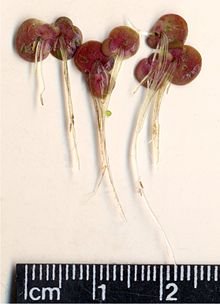Spirodela
This article needs additional citations for verification. (July 2024) |
| Spirodela | |
|---|---|

| |
| Spirodela polyrrhiza | |
| Scientific classification | |
| Kingdom: | Plantae |
| Clade: | Tracheophytes |
| Clade: | Angiosperms |
| Clade: | Monocots |
| Order: | Alismatales |
| Family: | Araceae |
| Subfamily: | Lemnoideae |
| Genus: | Spirodela Schleid. 1839 |
| Synonyms[1] | |
|
Landoltia Les & D.J.Crawford | |
Spirodela is a genus of aquatic plants, one of several genera containing plants commonly called duckweed. Spirodela species are members of the Araceae under the APG II system. They were formerly members of the Lemnaceae.[2][3]
Description
[edit]Spirodela species are free-floating plants that have their stem transformed into leaf-like structures called fronds; each plant is represented by a frond with roots, therefore they do not have leaves.[4] Two to five plants may remain connected to each other.
Plants are green, but may turn red due to the presence of anthocyanin.[4] Multiple roots (5 to 20, depending on the species) emerge from each frond. Spirodela is larger (10 mm (0.39 in)) than Lemna (2 mm (0.079 in) – 5 mm (0.20 in), with one root per frond).[5]
Certain species of Spirodela overwinter as turions, dormant starchy shoots[4] that lack air pockets, which sink to the bottom of the water. In spring, turions rise to the surface and germinate.
Spirodela often forms floating mats with related species (e.g. Lemna and Wolffia).
The genus is virtually cosmopolitan in distribution.[1][5]
Species
[edit]There are currently 2 recognized species in this genus:[6][7]
- Spirodela polyrhiza (L.) Schleid. - cosmopolitan
- Spirodela intermedia W.Koch
References
[edit]- ^ a b Kew World Checklist of Selected Plant Families[permanent dead link]
- ^ Govaerts, R. & Frodin, D.G. (2002). World Checklist and Bibliography of Araceae (and Acoraceae): 1-560. The Board of Trustees of the Royal Botanic Gardens, Kew.
- ^ Landolt, E. (1986) Biosystematic investigations in the family of duckweeds (Lemnaceae). Vol. 2. The family of Lemnaceae - A monographic study. Part 1 of the monograph: Morphology; karyology; ecology; geographic distribution; systematic position; nomenclature; descriptions. Veröff. Geobot. Inst., Stiftung Rübel, ETH, Zurich.
- ^ a b c Schou, Jens Christian; Moeslund, Bjarne; van de Weyer, Klaus; Wiegleb, Gerhard; Lansdown, Richard; Holm, Peter; Båstrup-Spohr, Lars; Sand-Jensen, Kaj (2023). Aquatic plants of northern and central Europe including Britain and Ireland. Wildguides. Princeton: Princeton University Press. ISBN 978-0-691-25101-1.
- ^ a b Flora of North America
- ^ Bog, Manuela; Appenroth, Klaus-J.; Sree, K. Sowjanya (2019-12-17). "Duckweed (Lemnaceae): Its Molecular Taxonomy". Frontiers in Sustainable Food Systems. 3. doi:10.3389/fsufs.2019.00117. ISSN 2571-581X.
- ^ Sree, K; Bog, Manuela; Appenroth, Klaus (2016). "Taxonomy of duckweeds (Lemnaceae), potential new crop plants". Emirates Journal of Food and Agriculture. 28 (5): 291. doi:10.9755/ejfa.2016-01-038. ISSN 2079-052X.
External links
[edit]- Armstrong, W. (2005) Wayne Armstrong's treatment of the Lemnaceae Archived 2012-05-16 at the Wayback Machine.
- Cross, J.W. (2006). The Charms of Duckweed.
- The Duckweed Genome Project
